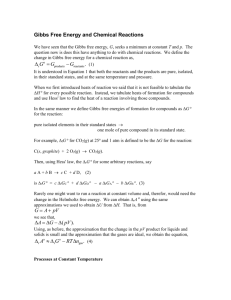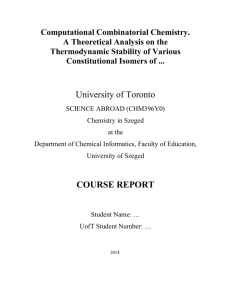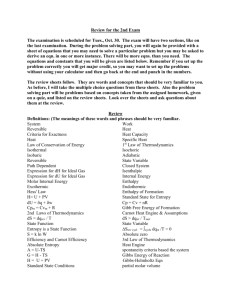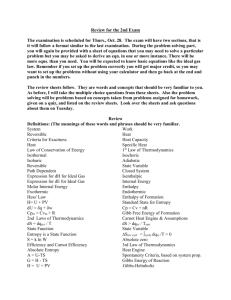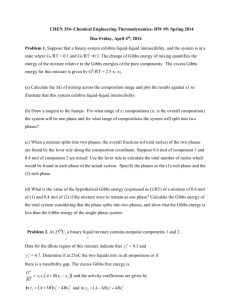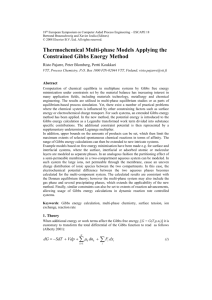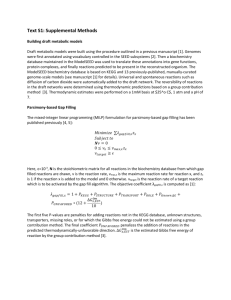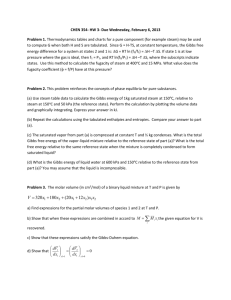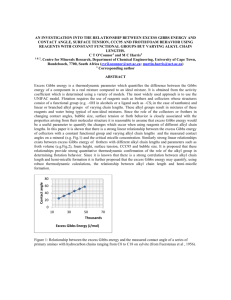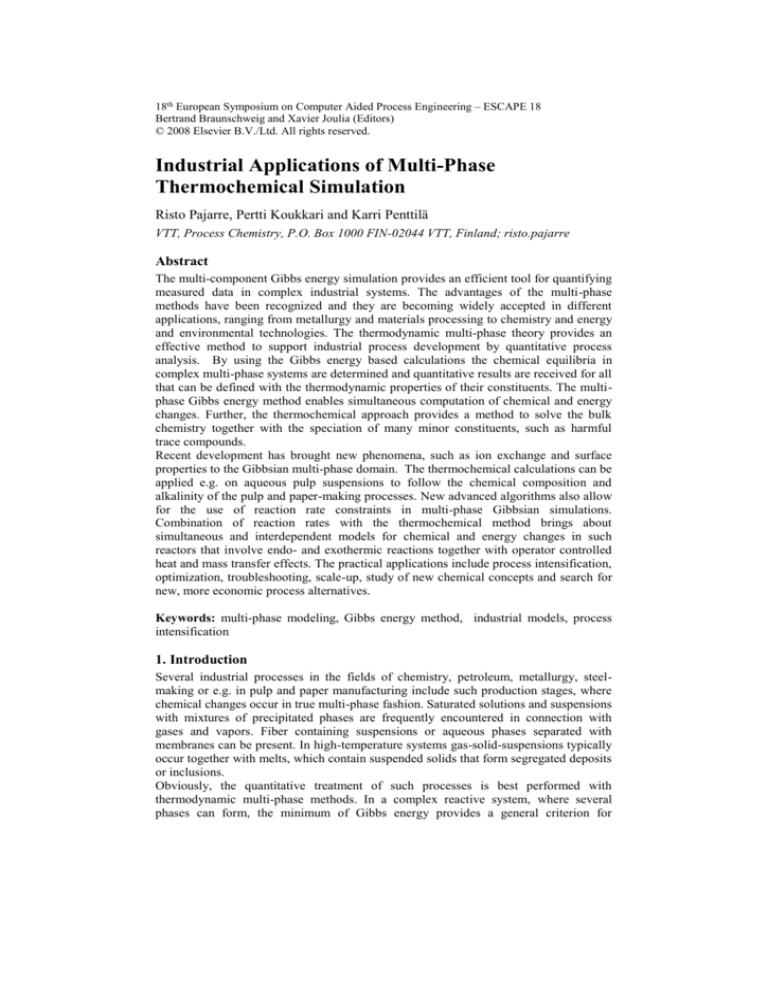
18th European Symposium on Computer Aided Process Engineering – ESCAPE 18
Bertrand Braunschweig and Xavier Joulia (Editors)
© 2008 Elsevier B.V./Ltd. All rights reserved.
Industrial Applications of Multi-Phase
Thermochemical Simulation
Risto Pajarre, Pertti Koukkari and Karri Penttilä
VTT, Process Chemistry, P.O. Box 1000 FIN-02044 VTT, Finland; risto.pajarre
Abstract
The multi-component Gibbs energy simulation provides an efficient tool for quantifying
measured data in complex industrial systems. The advantages of the multi-phase
methods have been recognized and they are becoming widely accepted in different
applications, ranging from metallurgy and materials processing to chemistry and energy
and environmental technologies. The thermodynamic multi-phase theory provides an
effective method to support industrial process development by quantitative process
analysis. By using the Gibbs energy based calculations the chemical equilibria in
complex multi-phase systems are determined and quantitative results are received for all
that can be defined with the thermodynamic properties of their constituents. The multiphase Gibbs energy method enables simultaneous computation of chemical and energy
changes. Further, the thermochemical approach provides a method to solve the bulk
chemistry together with the speciation of many minor constituents, such as harmful
trace compounds.
Recent development has brought new phenomena, such as ion exchange and surface
properties to the Gibbsian multi-phase domain. The thermochemical calculations can be
applied e.g. on aqueous pulp suspensions to follow the chemical composition and
alkalinity of the pulp and paper-making processes. New advanced algorithms also allow
for the use of reaction rate constraints in multi-phase Gibbsian simulations.
Combination of reaction rates with the thermochemical method brings about
simultaneous and interdependent models for chemical and energy changes in such
reactors that involve endo- and exothermic reactions together with operator controlled
heat and mass transfer effects. The practical applications include process intensification,
optimization, troubleshooting, scale-up, study of new chemical concepts and search for
new, more economic process alternatives.
Keywords: multi-phase modeling, Gibbs energy method, industrial models, process
intensification
1. Introduction
Several industrial processes in the fields of chemistry, petroleum, metallurgy, steelmaking or e.g. in pulp and paper manufacturing include such production stages, where
chemical changes occur in true multi-phase fashion. Saturated solutions and suspensions
with mixtures of precipitated phases are frequently encountered in connection with
gases and vapors. Fiber containing suspensions or aqueous phases separated with
membranes can be present. In high-temperature systems gas-solid-suspensions typically
occur together with melts, which contain suspended solids that form segregated deposits
or inclusions.
Obviously, the quantitative treatment of such processes is best performed with
thermodynamic multi-phase methods. In a complex reactive system, where several
phases can form, the minimum of Gibbs energy provides a general criterion for
2
R. Pajarre et al.
equilibrium in the closed system. During the last years, the Gibbsian approach has been
extensively introduced to industrial process simulation. With the multi-phase approach,
a remarkable accuracy of the models (when compared with industrial practice) has often
been achieved. In what follows, the thermochemical method is briefly outlined and two
practical industrial examples, representing an aqueous (pulp) suspension process model
and simulation of a high-temperature multi-phase reactor are presented.
2. The Thermodynamic Simulation Method
The thermochemical method involves the minimisation of the Gibbs energy of a given
thermodynamic system in terms of the molar amounts of its constituents. The
temperature and pressure of the system must be defined and the additional constraint
needed is the elemental balance of the chemicals involved. The minimisation of the
Gibbs energy can be done when the chemical potentials of the substances are known as
a function of their standard state and temperature-dependent excess Gibbs energy data.
The Gibbs energy of the multicomponent system is written in terms of the chemical
potentials as follows
N N
G nk k
(1)
k
where k k (T , p, nk ) is the chemical potential of the species k in the respective phase
and nk is its molar amount, N is the number of phases present and Nα is the number
of constituents in phase . The Gibbs energy is an extensive state variable and the
chemical potential k is the partial molar Gibbs energy of the constituent k. The
chemical potential is commonly written in terms of the standard molar enthalpies,
entropies and the temperature dependent molar heat capacities of the constituents. This
expression as input data of the Gibbs energy calculations provides the user not only
with the Gibbs energy but also with other state functions of the system, such as the
enthalpy. Therefore, a general advantage of the non-stoichiometric Gibbsian method in
practical process simulation is that the calculation is simultaneously dealing with the
complete heat and chemical balance of the multi-phase and multi-component chemical
change.
Gibbs energy minimisation is usually done by imposing the mass balance condition of
the system of interest, and thus a composition corresponding to the global minimum in
terms of the molar amounts of the constituents is produced (Eriksson, 1975). During the
last few years, new methods have emerged which apply the Gibbsian method equally
for time-dependent process calculations (Koukkari 1993). The recently developed
extended matrix technique allows for the conservation of both mass and the
thermodynamic properties of the system during the kinetically constrained Gibbs energy
minimisation (Pajarre, 2001; Koukkari et al., 2001). The essential feature of the method
is that the reactions that are kinetically controlled, are frozen during the Gibbsian
equilibrium calculation. The reaction rates (Rr) are introduced as usual in terms of their
rate coefficients, concentrations and temperature
Rr F kr , A, B,...,M
(2)
The rate constant (kr) is a function of temperature and typically follows the Arrhenius
equation
Industrial Applications of Multi-Phase Thermochemical Simulation
ln kr ln r
r
3
(3)
T
where r and r are parameters defining the frequency factor and the activation energy
of the reaction r. The expressions for global reaction rate laws vary considerably
according to the particular application under consideration.
In Fig. 1 a volume element of the dynamic chemical system is shown. It is assumed that
no external force fields are present and that no external work is done for the system. The
volume element is defined by its temperature, pressure and chemical composition. The
element encounters an entering reactant flow (mR) and the respective output of products
(mp) is leaving the element (diffusive side streams are omitted for simplicity). The
volume element is characterised with measurable temperature and pressure as well as
composition in terms of the molar amounts of substances nk. Further, the exchange of
heat (Q) between the control volume and its surroundings is shown.
mR
mP
T, p, nk
Q
Figure 1. The volume element of a chemically reactive system.
As the temperature, pressure and the molar amounts of substances are known, the Gibbs
energy G = G(T,P,nk) is defined for the volume element. The minimisation of Gibbs
energy at given T and p in terms of the molar amounts is the traditional method to
calculate the global equilibrium composition of the system. The optional constraints
then may partly replace the elemental balance and T-p-conditions of the original
minimisation procedure and are usually introduced with algorithmic techniques
(Koukkari et al., 2001, Koukkari and Pajarre, 2006). The versatility of the Gibbsian
process simulation is presented in a simple block diagram in Fig. 2.
Elemental balance constraints
Conditions
Heat/mass transfer constraints
Reaction rate constraints
- input amounts
- T, p
(optional)
(optional)
min (G)
at given conditions
• concentrations
• activities
• chemical potentials
• other intensive properties
(p, T, pH, redox, etc.)
• extensive state properties
(G, H, S, C, V etc.)
Figure 2. The Gibbsian method in process simulation.
The thermochemical technique is applicable in all such situations where thermodynamic
(e.g. temperature) measurements can be made and where sufficient data is available to
4
R. Pajarre et al.
define the free energy of the system and its constituents. Then, as far as we follow only
the physico-chemical changes in the system, it is possible to define the Gibbs energy at
any such stage of the process. Following the thermodynamic relations, the mutually
interdependent properties are available for the validation of the model.
3. Models for Pulp and Paper-making Chemistry
A typical example of an industrial multi-phase system is the chemical state of a fibre
suspension in which N ≥ 4 , viz. the gas phase, two aqueous phases and one or several
precipitating phases (Table 1). Applying the Donnan equilibrium theory, the fibre
acidity can be taken into account by describing the fibre in the model as a secondary
aqueous phase characterised by its protolysing acid groups and separated from the
primary aqueous phase by a semipermeable wall (Pajarre, Koukkari 2006). This
interface allows the transfer of mobile ions while the anionic groups of the protolytes
remain in the secondary phase.
Table 1. Multi-phase system of a pulp suspension
Gas
N2, O2, H2O, CO2…
External solution
H2O, H+, OH-, Na+, Ca2+, Cl-, HSO4-, SO42-, HCO3-, CO2-, CO2,…
Fibre phase
H2O, H+, OH-, Na+, Ca2+, Cl-, HSO4-, SO42-, HCO3-, CO2-, CO2,…, AcidaH, Acida-,…
Solid phases
CaCO3, MgCO3, CaSO4,…
Donnan ion exchange theory combined with multi-phase thermodynamic model
provides an efficient method to quantify the important process variables. Aqueous
volumes inside and outside fiber walls are treated as separate solution phases. The use
of general thermodynamic formalism also enables the use of non-ideal solution models
and the simultaneous consideration of a large number of solubility equilibria. The
method allows for efficient calculation of cation distributions in bleaching and pHalkalinity control in the wet end of paper machines. Fig. 3 shows comparison of
calculated alkalinity values to process measurement in five subsequent mill test runs,
where the multi-phase model was applied as a steady state process simulation during
mill trial runs of non-stoichiometric bicarbonate (CO2/NaOH) pH-buffering. The values
have been scaled to highest measured value ≡ 1.
Industrial Applications of Multi-Phase Thermochemical Simulation
1
measured
0.8
0.6
0.4
0.2
0.2
0.4
0.6
0.8
1
model
Figure 3. Comparison of the modeled alkalinity values with experimental results from five
subsequent mill tests.
4. Models for Chemical Reactors
Principles presented in equations (1)-(3) can be generally applied for various chemical
reactors. The combination of reaction kinetic and heat transfer equations with the
thermodynamic multicomponent calculation is of particular interest in kiln reactors, as
direct measurement from inside a rotary kiln is quite difficult to perform. Yet, rotary
kilns are common separator reactors in the mineral processing, metallurgical and
chemical industries. Usually they operate in counter-current fashion, where the
condensed raw material is fed into the kiln from the ’feed end’ and the hot gas enters
from the opposite ’burner end’.
Cell1
Gas out
Bed in
Celli
CellN
Gas in eq.
Gas in eq.
convection+
diffusion
convection+
diffusion
Gas in eq.
convection+
diffusion
dust+
volatiles
dust+
volatiles
dust+
volatiles
condensed
Bed in eq.
condensed
Bed in eq.
condensed
Mass transfer of gas species
between
bed
and
gas.
Convection
and
diffusion
between gas and bed.
Gas in
Mass transfer of condensed
species between bed and gas.
Dusting of solid particles and
formation of liquid phases.
Bed out
Bed in eq.
Figure. 4. The thermochemical model of a countercurrent kiln
In the Gibbs’ian model the kiln is divided into number of successive calculation cells, in
which the temperature of bed, gas, and inner and outer wall of the kiln are assumed as
constant. The volume elements of material bed and gas are described as open
thermochemical systems, which transform mass and heat with each other. For
simplicity, heat transfer is assumed to be radial. The state properties of the volume
elements are calculated by minimizing their Gibbs energy and by taking into account
the mass and heat transfer between the volume elements and the surroundings. The
time-dependent reactions in material bed are taken into account by separating the phases
into reactive and inert parts in each calculation cell according to reaction rate
parameters. Axial plug flow is assumed for both the gas and the bed phase in the steady
state model.
5
6
R. Pajarre et al.
1600
12000
1400
2CaO*(AlFe)2O3(s)/
2CaO*Fe2O3(S)
2CaO*(AlFe)2O3(s)/
2CaO*Al2O3(S)
Slag(l)/CaO
1200
10000
1000
8000
800
6000
600
4000
400
2000
Temperature
Mass flow\kg/h
Bed stream - solution phases
14000
Slag(l)/(Al2O3)2.000
Slag(l)/SiO2
Slag(l)/MgO
Slag(l)/(Fe2O3)2.000
Slag(l)/FeO
200
Temperature
0
0
0
20
40
60
80
position/m
Figure 5. Calculated one-dimensional temperature profile and the amounts of mixture
constituents (solution phases) in a countercurrent kiln used in cement production.
5. Summary
Multi-phase thermodynamic computation provides an efficient tool for chemical
engineering. Concepts developed in physical chemistry and thermodynamics are applied
for complex industrial conditions, giving a rigorous approach to solve practical
problems. The range of potential applications of the Gibbs’ian multi-phase method is
broad, as basically macroscopic thermodynamics can be used combined with reaction
kinetics and transport processes.
References:
G. Eriksson, 1975. Thermodynamic studies of high temperature equilibria XII, Chemica Scripta,
8, 100-103.
P. Koukkari, 1993. A physico-chemical method to calculate time-dependent reaction mixtures,
Comput. Chem. Eng., 17(12), 1157 – 1165.
P. Koukkari, R. Pajarre, K. Hack, 2001. Setting kinetic controls for complex equilibrium
calculations, Zeitschrift fur Metallkunde, 92, 1151-1157.
P. Koukkari, R. Pajarre, 2006. Introducing mechanistic kinetics to the Lagrangian Gibbs energy
calculation, Comput. Chem. Eng., 30, 1189– 1196.
R. Pajarre, 2001. Modelling of equilibrium and non-equilibrium systems by Gibbs energy
minimisation, Master’s Thesis, Helsinki University of Technology
R. Pajarre, P. Koukkari, 2006. Inclusion of Donnan Effect in Gibbs Energy Minimization, Journal
of Molecular Liquids, 125, 58-61.

